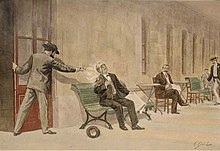Michele Angiolillo
Michele Angiolillo Lombardi (Foggia, June 5, 1871-Vergara, August 20, 1897) was an Italian journalist and anarchist, known for having assassinated Antonio Cánovas del Castillo, president of the Council of Ministers of Spain.
Background and historical context
The magnification of Cánovas del Castillo occurred in turbulent years characterized by numerous acts of propaganda for the act and anarchist terrorism, against the authorities, in which dozens of civilians were frequently killed.
The bomb from the Corpus Christi Procession on Cambios Nuevos street
On June 7, 1896, there was a terrorist act. Someone threw a bomb on the public that attended the passage of the Corpus Christi procession, at the height of Arenas de Cambios street in Barcelona. The explosion caused twelve deaths and dozens of injuries, as can be read in the numbers corresponding to June 8 to 19 in the newspaper La Vanguardia[citation required ]. There are discrepancies about the death toll.
Bomb against Martínez Campos
The Corpus Christi attack in June 1896 in Barcelona was preceded by two other attacks. The first of these was the bomb, launched by the anarchist Paulino Pallàs against the General Captain of Catalonia Martínez Campos. In that other attack, the civil guard Jaime Tous died.
The other is the attack on the Liceo, in which 22 people died and another 35 were injured.
Public reaction
All these terrorist attacks against the civilian population aroused a growing social indignation that demanded a firm repressive response against anarchists, socialists and revolutionaries. Nearly four hundred people considered revolutionaries or subversives were imprisoned in the castle of Montjuic. Of these, 87 were brought to trial for causing the deaths of 12 people and injuries to 35[citation required]. The prosecutor requested 28 death sentences and 59 life sentences, although in the end only five defendants were executed and between 9 and 20 life sentences were imposed. Other defendants, although acquitted by the court, were deported to Río de Oro by government order. of Canovas del Castillo. The process was carried out by a military court without adequate procedural guarantees, and serious irregularities abounded in it, although the government did not admit the accusations of torture, denounced by prisoners and their relatives.
In this context of indiscriminate repression against anarchist militants, most of whom had no blood crimes, it seems that it would have prompted some anarchists to plan to avenge said repression in the form of assassination.
Assassination of Cánovas
Some historians, and Angiolillo's own confession before his execution, suggest that the reported torture and excessive sentences imposed on anarchist militants were the reason that prompted the Italian anarchist Angiolillo to embark from Paris to Spain via London to kill the President of the Government at the time, Antonio Cánovas del Castillo. Angiolillo apparently intended to kill at least one young member of the Spanish royal family, but he was persuaded by the Puerto Rican revolutionary Ramón Emeterio Betances to make an attempt on Cánovas. There is some evidence that Betances processed Angiolillo's free passage to Spain through the use of a false identity, and it is even speculated that he financed his trip with a remittance of a thousand francs.
However, Angiolillo had ties to exiled Cuban independence circles in London, who could have financed the attack as well. Cánovas' policy of "to the last man and to the last peseta" by then it had caused half a million deaths in Cuba. In any case, when Angiolillo arrived in Paris from London, he was already in the network of the Antillean independentistas.
According to Josep Pla, Angiolillo spent time in Barcelona, relating to the environment of the Catalan newspaper "L'Avenç", which included Pompeu Fabra, Casas, Cortada, among others. He was interested, apparently, only in cultural matters, and said environment never knew of his plans, which he carried out a short time later.
Angiolillo arrived in Madrid shortly after his meeting with Betances, looking for the whereabouts of the prime minister. He was on vacation at the Santa Águeda thermal station, in Mondragón, Guipúzcoa. At the beginning of August, Angiolillo took the train at the North station in Madrid and got off in the town of Zumárraga. There he took a car that led him to the Santa Águeda Spa. He introduced himself as Emilio Rinaldi, a bookkeeper and correspondent for the Italian newspaper ' Il Popolo '. A few days later, on August 8, 1897, he killed Cánovas del Castillo with three shots, while he was reading a newspaper.
Angiolillo was immediately arrested, tried, and promptly executed by garrotte on August 20 of that same year. The execution was carried out by the Castilian Gregorio Mayoral Sendino in the Vergara prison and was buried in his cemetery.He declared that he had killed Cánovas in revenge for the executions of the Montjuïc Trial.
The New York Times wrote: "ANGIOLILLO DIES BRAVELY [...] The killer clearly uttered the word "germinal" before he died [...] Angiolillo allowed authorities to capture him and vehemently denied the involvement of other parties in the murder. He was executed by garrote in the nearby town of Vergara."
Currently the Vergara prison is occupied by the "gaztetxe", which means "youth house".
Contenido relacionado
Olmec culture
V millennium BC c.
Murphy's War


